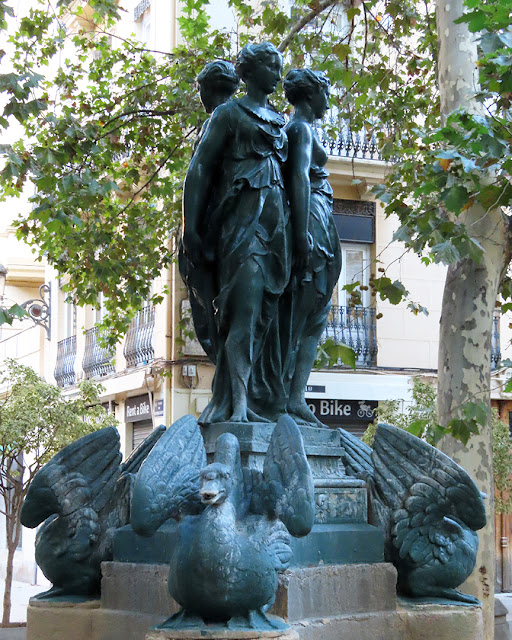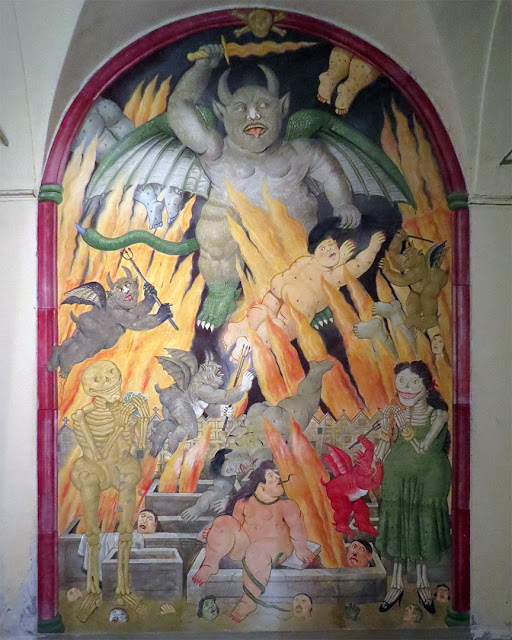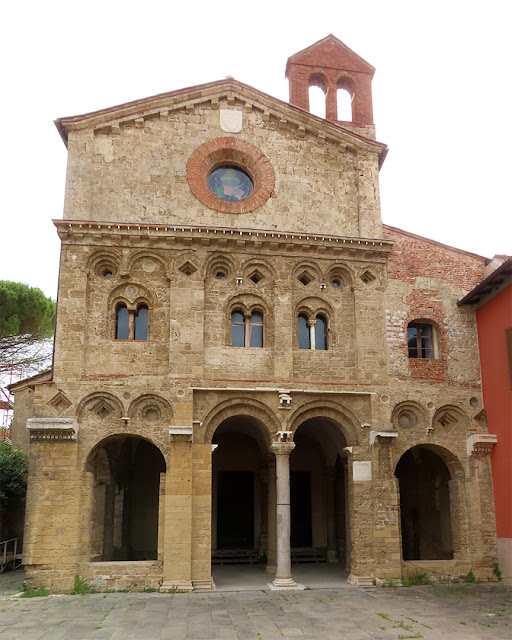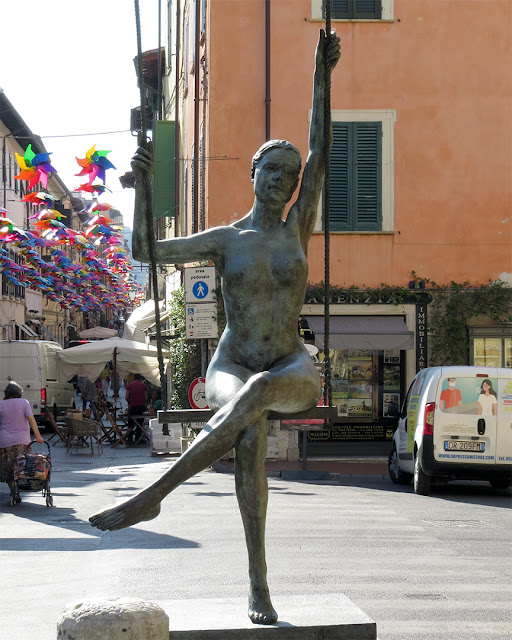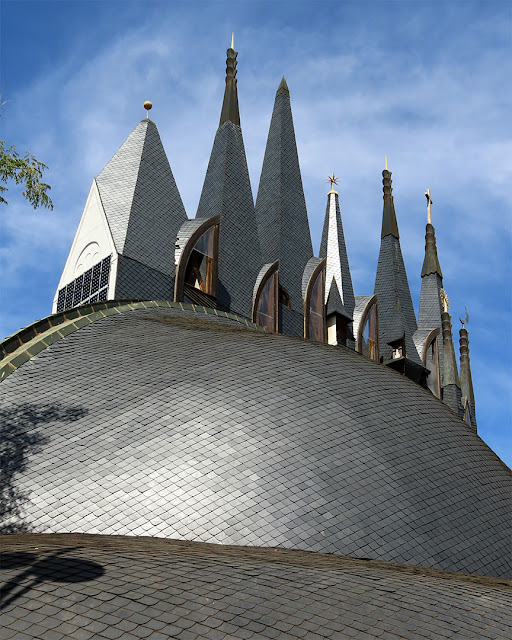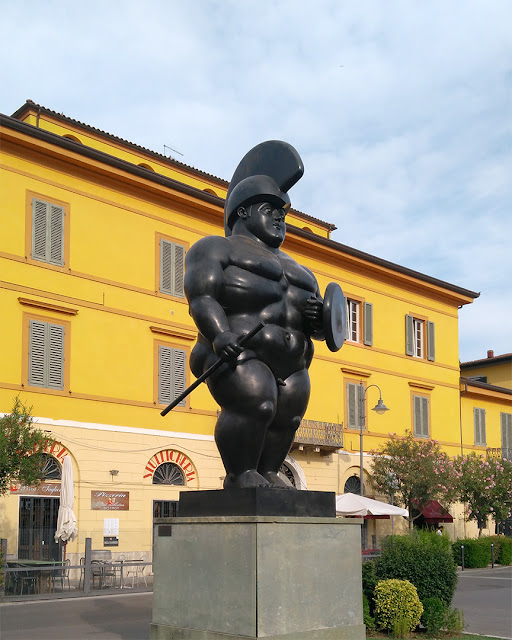Saturday, December 31, 2022
Pecking Bird
“Pecking Bird” By Gary Hume, 2013
Regent's Place
London, September 2014
“Here at Regent’s Place, our site-specific artwork by Gary Hume (b 1952 UK) draws inspiration from similar themes. Titled Pecking Bird, this monumental 20-panel installation stands almost 14 metres above the traffic and pedestrians at the Brock Street and Hampstead Road intersections. Comprising Hume’s trademark clear lines and bold colours, Pecking Bird was commissioned by British Land for Regent’s Place in 2012.” (Art At Regent’s Place, Regent’s Place)
Friday, December 30, 2022
Porta del Paradiso
“Porta del Paradiso” (Gate of Paradise) by Fernando Botero, 1993
Chiesa della Misericordia (Sant'Antonio Abate / San Biagio) Via Mazzini
Pietrasanta, September 2021
Thursday, December 29, 2022
Fuente de las Tres Gracias
Fuente de las Tres Gracias, 1853 (1909)
Plaça de Rodrigo Botet
Valencia, September 2022
“This fountain is a 19th century replica of a famous group by Germain Pilon. The original, kept at the Louvre Museum in Paris, is made of marble and was commissioned by Catherine de Médicis in 1561 to receive the heart of Henri II.”
Wednesday, December 28, 2022
Arsenali della Repubblica
Arsenali della Repubblica (The Republican Shipyards)
Piazza della Terzanaia
Pisa, June 2022
“The arsenals (shipyards) of the Republic were an ancient complex of buildings aimed at the production and repair of galleys of the ancient Republic of Pisa. Today only one building remains, partially destroyed during the bombing of World War II and restored in 2015. The first news of the republican arsenals date back to the beginning of the thirteenth century when, outside the western side of the city walls, the Pisan dockyard was built, where new boats were built or galleys were repaired. Around the middle of the century the area was fortified with the construction of other sides of the wall, leaning against the urban circle. At the end of the fourteenth century part of the arsenals were converted to warehouses and factories of arms. After the Florentine conquest the area was interdicted to Pisani, assuming the function of fortified citadel. Since the mid-sixteenth century ceased to be a military fortress and there was established the Botanical Garden, later transferred to another part of the city. In the eighteenth century there were located the prisons and was built a cavalry barracks, hard hit by the bombing of 1943, along with most of the medieval arsenals. In the 14th century, several changes were made, including the demolition of the thirteenth-century porticoes and the construction of new porticoes for galleys with pointed arches: these are the latter structures recovered today for five lanes, after the disastrous bombing of 1944. The complex was restored in 2015. The Arsenals are home to exhibitions, conventions and shows.” (The Republican Shipyards, Terre di Pisa)
Tuesday, December 27, 2022
Sacristía
Frescos by Luca Giordano
Barrel vault of the sacristy
Catedral de Toledo (Toledo Cathedral)
Calle Cardenal Cisneros
Toledo, September 2022
“The sacristy exhibits treasures from the cathedral's collection, including many major works of art. It is a large space that includes the apartments of the ante-sacristy and the vestuary with its collection of garments. The ante-sacristy is a rectangular room decorated with paintings by the Italian artists Vincenzo Carducci and Eugenio Caxés, as well as Francisco Ricci and the Neapolitan Luca Giordano. The sacristy was designed by Francisco Vergara the Greater and Juan Bautista Monegro, in Herrerian style. The barrel vault, inset with lunettes accommodating the windows, is lavishly decorated with frescos by Luca Giordano. The principal theme is the Clothing of Saint Ildephonsus with the Chasuble, a theme that is repeated throughout the cathedral in paintings and sculpture.” (Toledo Cathedral, Wikipedia)
Monday, December 26, 2022
Porta dell'Inferno
“Porta dell'Inferno” (Gate of Hell) by Fernando Botero, 1993
Chiesa della Misericordia (Sant'Antonio Abate / San Biagio) Via Mazzini
Pietrasanta, September 2021
Sunday, December 25, 2022
Plaza de Castilla
Puerta de Europa (Gate of Europe) by Philip Johnson & John Burgee, 1996
Caja Madrid Obelisk by Santiago Calatrava, 2009
Plaza de Castilla
Madrid, September 2022
“The Gate of Europe towers (Puerta de Europa), also known as KIO Towers (Torres KIO), are twin office buildings near the Plaza de Castilla in Madrid, Spain. The towers have a height of 114 m (374 ft) and have 26 floors. They were constructed from 1989 to 1996. The Puerta de Europa is the second tallest twin towers in Spain after the Torres de Santa Cruz in Santa Cruz de Tenerife.” (Gate of Europe, Wikipedia)
“The Caja Madrid Obelisk (Spanish: Obelisco de la Caja, Columna de Calatrava or Obelisco de Calatrava) is an obelisk designed by Santiago Calatrava located in the Plaza de Castilla in Madrid, Spain. The monument, intended to commemorate the 300th anniversary of Caja Madrid, was donated by the saving bank to the city of Madrid.” (Caja Madrid Obelisk, Wikipedia)
Saturday, December 24, 2022
Church of San Zeno
The church of San Zeno
Largo San Zeno
Pisa, June 2022
“The church is documented going back to 1029. It was part of a monastery built over pre-existing edifices, and, until the 15th century, it had also a hospital. In the 12th century it was held by the Camaldolese monks. The church has a nave and two aisles. The façade is preceded by a portico supported by pilasters and a central columns. The second row has mullioned windows and decorations with lozenges and small circular windows, with ceramic basins by Islamic masters. The interior has ancient Roman capitals and traces of medieval paintings.” (San Zeno, Wikipedia)
Friday, December 23, 2022
Plaza de la Corredera
Tables and chairs
Plaza de la Corredera
Córdoba, September 2022
“Archaeological excavations have unearthed a series of wonderful mosaics from the Roman period, which are now on show in the Castle of the Christian Monarchs. The present-day square is rectangular with arched porticos running around the ground floor, designed in the style of the old city squares of Castille, of which it is the only one of its kind in Andalusia. It was used in olden days as a bullring, and to this day there is a street named Toril (Bulls’ enclosure). The square has seen everything, from autos de fe and public addresses to public executions during the French Invasion, and now contains a number of cafes and bars, as well as hosting a Medieval Market in the month of January.” (Plaza de la Corredera, Turismo de Córdoba)
Thursday, December 22, 2022
Ragazza sull'altalena
“Ragazza sull'altalena” (Girl on a Swing) by Daphne Du Barry
Piazza dello Statuto
Pietrasanta, September 2021
Wednesday, December 21, 2022
Pabellón de Hungría
Pabellón de Hungría (Hungarian pavilion) for Seville Expo '92 by Imre Makovecz
Calle Louis Pasteur
Isla de La Cartuja
Seville, September 2022
“Imre Makovecz's Hungarian pavilion, widely regarded as the most inventive structure at Expo '92 here, soars free from the fair's architectural cacophony like some dizzy fantasy. Built from wood carved in folk styles and bearing a gray slate roof, it seems inspired by village churches but leaps beyond any one model with an exuberance that recalls the Catalan Antonio Gaudi. Inside, the building's conceptual basis becomes clearer, with no loss of wit and style. The interior is divided, one portion symbolizing Hungary facing the West, with a simplified Baroque church front. Pass through that facade and one finds Hungary facing East, the wall exploding with undulating Slavic-style facades (more gray slate) and carved portals. There is also a ‘Tree of Life’ on the Western side, a jumble of roots and branches with a glass floor so that visitors can see the whole thing.” (Makovecz Hungarian Pavilion in Seville, Solaripedia)
Tuesday, December 20, 2022
Monday, December 19, 2022
Palau de la Generalitat
Palau de la Generalitat
Palacio de la Generalidad
Plaza de Manises
Valencia, September 2022
“The design of Palace goes back to 1418. This rectangular building was originally built as a tax office for the Crown. It is flanked by two turrets, while the lower central part set in between gives an impression of unity. Work began in 1421, using a late gothic style. Between 1481 and 1520, the splendid gothic courtyard was enlarged, the Chapel was started and the façade on the Plaza de Manises was built by the architects Pere Compte and Joan Guiverro. The renaissance turret designed by Joan Corbera was finished in 1521. From that period until 1940, when the new turret was built, no other work of importance took place. The new turret was finished in 1952 and the design by architect Luis Albert Ballesteros, was an attempt to copy the original one.” (Palau de la Generalitat, Visit Valencia)
Sunday, December 18, 2022
Il cavallino
“Il cavallino” (The Little Horse) by Ferruccio Vezzoni
Piazza dello Statuto
Pietrasanta, September 2021
Saturday, December 17, 2022
Gigantes y cabezudos
Gigantes (Processional giants)
Catedral de Toledo (Toledo Cathedral)
Calle Cardenal Cisneros
Toledo, September 2022
“The giants are usually hollow figures several meters tall, with a painted paper maché head and arms, the rest of the body being covered in cloth and other clothing. Their frame is usually made of wood or aluminium, with carton-pierre—a mixture of papier-mâché and plaster of paris—used to make the head and hands. The frame of the body is hidden by cloth, and the arms typically have no structural element to allow them to swing in the air when the giant is turned. Within the frame is an individual controlling the giant. He carries a harness on his shoulder that is linked to the internal structure, and will move and shake the giant in a dance, usually accompanied by a local marching band. Typically, these dances will include at least two giants, the male gigante and the female giantess, called giganta or gigantona, though some towns have multiple couples. The figures usually depict archetypes of the town, such as the bourgeois and the peasant woman, or historical figures of local relevance, such as a founding king and queen, or pairs of Moorish and Christian nobles.” (Processional giant, Wikipedia)
Friday, December 16, 2022
Piazza delle Gondole
Water lilies
Piazza delle Gondole
Pisa, June 2022
“The Piazza delle Gondole (Square of Gondolas) is a piazza in Pisa, Italy. It is next to one of the city gates in the medieval walls. The square includes a small basin where boats used to dock.” (Piazza delle Gondole, Wikipedia)
Thursday, December 15, 2022
Calle de Alcalá
Street musicians
Calle de Alcalá
Madrid, September 2022
“Calle de Alcalá is among the longest streets in Madrid. It starts at the Puerta del Sol and goes on for 11 kilometres (6.8 mi), to the northeastern outskirts of the city. Henry David Inglis described it in 1837 as ‘long, of superb width, and flanked by a splendid range of unequal buildings’.” (Calle de Alcalá, Wikipedia)
Wednesday, December 14, 2022
Tuesday, December 13, 2022
Fuente del Potro
Fuente del Potro, 1577
Plaza del Potro
Córdoba, September 2022
“The Plaza del Potro is a public square in the Spanish city of Córdoba. Rectangular in shape, one end of the plaza has a fountain topped by the figure of a colt with its front legs raised holding a sign with the coat of arms of the city. This Renaissance-style fountain dates from 1577, and the colt which gives its name to the square was added a century later. Until 1847 was located on the opposite side of the plaza. Since 1924, the other end of the square has a monument dedicated to the Triumph of the archangel Raphael. Among the buildings overlooking the square is the famous Posada del Potro, mentioned by Cervantes in Don Quixote, in addition to the city's Museum of Fine Arts and the Museum Julio Romero de Torres. The reference in "Don Quixote" can be found in the Penguin Classics edition, translated by John D. Rutherford, in Chapter III as ‘... Potro in Cordova ...’, and in the Barnes & Noble edition, translated by Tobias Smollett, in Chapter III as ‘... the spout of Cordoba ...’. The much celebrated reference to the place and neighbourhood is made by an inn keeper making fun of Don Quixote with sarcastic chivalrous references to infamous brothels, disreputable districts and dens of iniquity.” (Plaza del Potro, Wikipedia)
Monday, December 12, 2022
Pisa a Garibaldi
“Pisa a Garibaldi” (Pisa to Garibaldi)
Giuseppe Garibaldi by Ettore Ferrari, 1892
Piazza Garibaldi
Pisa, April 2022
Sunday, December 11, 2022
Saturday, December 10, 2022
Friday, December 9, 2022
Palau del Marqués de Dosaigües
Palace of the Marqués de Dos Aguas
(González Martí National Museum
of Ceramics and Decorative Arts)
Raconada de Federico Garcia Sànchiz
Valencia, September 2022
“The Palace of the Marquis of Dos Aguas (Spanish: Palacio del Marqués de Dos Aguas, Valencian: Palau del Marqués de Dosaigües) is a Rococo nobility palace, historically important in the city. It is located in one of the most central locations in the city of Valencia (Spain). It is a stately mansion that was the property of the Marqueses of Dos Aguas and is currently owned by the Spanish State. It houses the González Martí National Museum of Ceramics and Decorative Arts.” (Palace of the Marqués de Dos Aguas, Wikipedia)
Thursday, December 8, 2022
Pietro Leopoldo I
Pietro Leopoldo I by Luigi Pampaloni, 1829
Piazza Martiri della Libertà
Pisa, April 2022
“Leopold II (Peter Leopold Josef Anton Joachim Pius Gotthard; 5 May 1747 – 1 March 1792) was Holy Roman Emperor, King of Hungary and Bohemia, and Archduke of Austria from 1790 to 1792, and Grand Duke of Tuscany from 1765 to 1790. He was a son of Empress Maria Theresa and her husband, Emperor Francis I, and the brother of Marie Antoinette, Queen of France, Maria Carolina of Austria, Maria Amalia, Duchess of Parma, and Joseph II, Holy Roman Emperor. Leopold was a moderate proponent of enlightened absolutism. He granted the Academy of Georgofili his protection. Unusually for his time, he opposed capital punishment and abolished it in Tuscany in 1786 during his rule there, making it the first nation in modern history to do so. Despite his brief reign, he is highly regarded. The historian Paul W. Schroeder called him ‘one of the most shrewd and sensible monarchs ever to wear a crown’.” (Leopold II, Holy Roman Emperor, Wikipedia)
Wednesday, December 7, 2022
Alcázar de Toledo
Alcázar
Calle de la Union
Toledo, September 2022
“The Alcázar of Toledo (Alcázar de Toledo) is a stone fortification located in the highest part of Toledo, Spain. It is a large quadrangular building measuring 60 meters on a side, framed by four large towers 60 meters high, each crowned by the typical Madrid spire. Most of the city was rebuilt between 1939 and 1957 after the siege of the Alcázar during the Spanish Civil War. Once used as a Roman palace in the 3rd century, it was restored under Charles I (Charles V, Holy Roman Emperor) and his son Philip II of Spain in the 1540s. In 1521, Hernán Cortés was received by Charles I at the Alcázar, following Cortes' conquest of the Aztecs. The name is from Arabic al-qaṣr ‘the castle’ (ultimately, from Latin ‘castrum’).” (Alcázar of Toledo, Wikipedia)
Tuesday, December 6, 2022
San Francesco
“San Francesco” (Saint Francis) by Harry Marinsky, 2000
Via Martiri di Sant'Anna
Pietrasanta, September 2021
Monday, December 5, 2022
Catedral de la Almudena
Catedral de la Almudena (Almudena Cathedral)
Plaza de la Armería
Madrid, September 2022
“Almudena Cathedral (Santa María la Real de La Almudena) is a Catholic church in Madrid, Spain. It is the seat of the Roman Catholic Archdiocese of Madrid. The cathedral was consecrated by Pope John Paul II in 1993. When the capital of Spain was transferred from Toledo to Madrid in 1561, the seat of the Church in Spain remained in Toledo and the new capital had no cathedral. Plans for a cathedral in Madrid dedicated to the Virgin of Almudena were discussed as early as the 16th century but even though Spain built more than 40 cities overseas during that century, plenty of cathedrals and fortresses, the cost of expanding and keeping the Empire came first and the construction of Madrid's cathedral was postponed. Making the cathedral the largest that the world had ever seen was then a priority. All other main Spanish cities had centuries-old cathedrals, and Madrid had its own old churches, but the construction of Almudena only began in 1879. The cathedral seems to have been built on the site of a medieval mosque that was destroyed in 1083 when Alfonso VI reconquered Madrid. Francisco de Cubas, the Marquis of Cubas, designed and directed the construction in a Gothic revival style. Construction was interrupted by the Spanish Civil War, and the site lay abandoned until 1950, when Fernando Chueca Goitia adapted the plans of de Cubas to a baroque exterior to match the grey and white façade of the Palacio Real that stands directly opposite. The cathedral was completed in 1993, when it was consecrated by Pope John Paul II.” (Almudena Cathedral, Wikipedia)
Sunday, December 4, 2022
Synagogue of Pisa
Synagogue
Via Palestro
Pisa, April 2022
“Pisa’s synagogue is documented as having occupied the same building since the end of the sixteenth century. Initially rented, the complex was purchased in 1647 and first renovated in 1785. In 1861-65 it was renovated again, to a project by the architect Marco Treves. Treves was a Jew from Vercelli who was working in Tuscany at the time, where he designed some major works for his Jewish clientele. The façade was redesigned, and is simple with classical forms. The main hall of the synagogue, situated on the first floor, was raised, and Treves added the second order of windows, and the large pavilion vault adorned with understated neoclassical decorations. The furnishings were rearranged to reflect a new layout that had become popular during the emancipation era, inspired by Catholic churches. The tevah, enclosed by a semi-circular balustrade in walnut wood, was now placed next to the area of the aron hakodesh, creating a single focal point, similar to the chancel in churches. The central space was entirely occupied by pews, arranged in two sectors of parallel rows facing the aron. On the opposite side, above the entrance, is the women’s gallery.” (Synagogue of Pisa, Visit Jewish Italy)
Saturday, December 3, 2022
Double-tiered arches
Columns and double-tiered arches
Mezquita-Catedral de Córdoba
(Mosque–Cathedral of Córdoba)
Calle Cardenal Herrero
Córdoba, September 2022
“The original mosque had a roughly square floor plan measuring 74 or 79 square meters per side, equally divided between a hypostyle prayer hall to the south and an open courtyard (sahn) to the north. As the mosque was built on a sloping site, a large amount of fill would have been necessary to create a level ground on which to build. The original mosque's most famous architectural innovation, which was preserved and repeated in all subsequent Muslim-era expansions, was its rows of double-tiered arches. Much speculation has been offered on the inspiration for this particular design, including the alleged similarity of the arches to a forest of palm trees from Abd ar-Rahman's youth in Syria; however, a more technical motivation may have been the fact that the available columns being reused from previous buildings were not tall enough on their own to raise the ceiling to the desired height. The precedent of multi-tiered arches was also already present in the Iberian Peninsula thanks to remaining Roman aqueducts (e.g. the Milagros Aqueduct at Mérida).” (Mosque–Cathedral of Córdoba, Wikipedia)
Friday, December 2, 2022
Thursday, December 1, 2022
Carmen la Cigarrera
“Carmen la Cigarrera” by Sebastián Santos Rojas, 1973
Paseo de Cristóbal Colón
Seville, September 2022
“Carmen is a story known worldwide about love, passion and jealousy, located in Seville. Written by the French author Prosper Merimé in 1845, it was catapulted to fame thanks to the opera adaptation by Bizet. Its premiere on the 3rd of March 1875 was a failure. Nevertheless, it set the basis for a new type of opera and has become one of the most represented and best known French operas in the world. The story in the novel is set in Seville at the start of the nineteenth century and the lead characters are Carmen, a beautiful gypsy with a temper who works in the Royal Tobacco Factory in Seville and Don José, a former soldier who falls so deeply in love it drives him crazy. Some of the incidents in this renowned opera happen in the most representative locations in Seville, a route which can be explored.” (A walk through Carmen’s Seville, Hotel Ribera de Triana)
Subscribe to:
Posts (Atom)



